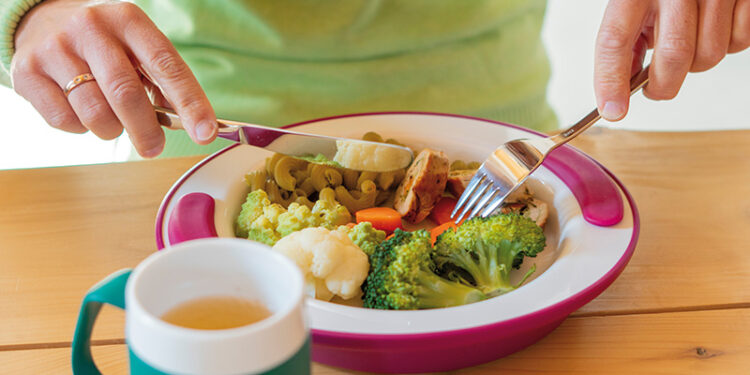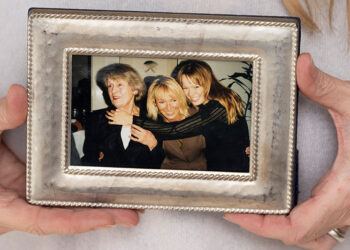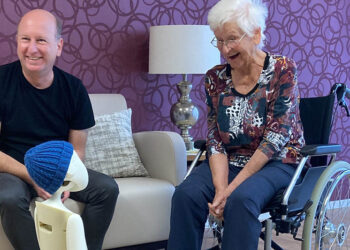Our topics:
In everyday life, it’s often the little things that make a big difference. Everyday aids are inconspicuous but effective – they provide support, structure and orientation and also give carers support. Many of these solutions have been around for a long time, they are just not visible enough. In this article, we give you an overview of the eating aids available on the market.
Maintain the pleasure of eating and drinking – even with restrictions
Eating is about enjoyment, pleasure and self-determination. The right aids are unobtrusive without looking like “I need help”. They provide security – and at the same time preserve dignity at the table. As we get older, our strength diminishes, our hands tremble and we become increasingly unsteady when gripping. In the case of illnesses such as dementia/Alzheimer’s and multiple sclerosis, or even after strokes, there are everyday helpers that counteract the typical limitations and symptoms. These little helpers, which we are now introducing, are not just practical – they give dignity and enjoyment to eating. It is important to choose aids that promote independence. Because once something is forgotten, it never comes back.
Which tricks make drinking & eating easier
There are many products on the market now that assist with eating and drinking: Ergonomically shaped drinking cups make it easier to drink independently, even with limitations. A high rim and non-slip base ensure that food stays in the containers and does not slip easily. Those who no longer have as much strength in their hands, suffer from severe tremors and can no longer close their hands will find support in special cutlery with a stronger, more ergonomic grip. Bowls with a sloping base automatically guide liquids and food in the direction of eating – ideal for one-handed eating. A large base ensures stability and steadiness when eating, for example when cutting. These products also do not tip over so easily if the cup or plate is accidentally knocked.
Look for dishwasher-safe & microwave-safe if you need these features for everyday use. Lightweight cups make drinking easier if you lack strength in your arms. Some products keep food and drink hot or cold for longer either through an insulating layer of air, or hot or cold water in the plate – for those who eat and drink at their own pace. Here is a selection of available solutions in detail:
Here we present, among another, the products of the German manufacturer Ornamin, which still produces high-quality products in Westphalia, Germany. Are solutions also available more cheaply from Chinese online retailers such as Temu? Yes, of course! However, we give priority to European solutions, where available, as we want to support high-quality European manufacturers. When it comes to eating aids in particular, high-quality, pollutant-free materials – free from harmful additives – are essential. Ornamin’s solutions are recyclable and, for the most part, can also be reground and reprocessed. The products were provided by the companies for testing.
Drink
Anti-slip concepts for wet & shaky hands
A secure grip when drinking despite wet or shaky hands: On the one hand, there are products with raised rings that run around the cups and thus ensure a secure grip. There are also cups with a slightly rough surface for a good grip. A thumb rest on the handle (which is slightly wider at the top) ensures stability when drinking. A large base ensures good stability and large, ergonomically shaped handles make it easier to grip with one hand. If you suffer from tremors, we recommend buying products with 2 handles for a stable grip with both hands.
Make sure that the products are made of unbreakable plastic in case the cup should slip out of your hand. In combination with drinking attachments, the liquid can also be easily dispensed.
Cups for limitations in the shoulder/neck area, motor limitations of the arms, hands & fingers, tremor
Cups with an internal cone (“ice cream cone shape” – see picture below) allow the user to drink without having to lean their head too far back or raise their arm too high. It is ideal for people with a restricted cervical spine, lack of fine motor skills or tremor. The cup also works in a semi-upright sitting position.
A large, ergonomically shaped handle is particularly important for people with motor impairments. Plus: stability thanks to a large base.
Drinking attachments for swallowing difficulties – slow drinking
Dysphagia is the technical term for swallowing disorders: Those affected have a problem swallowing solid food and liquids. In Germany, it is estimated that around 5 million people are affected. The symptoms often occur in older people who have suffered a stroke or suffer from a neurodegenerative disease such as dementia/Alzheimer’s or Parkinson’s disease. However, those affected by head and neck tumors, for example, are also affected.
There are several drinking attachments that help with swallowing difficulties. With these solutions, the liquid is dispensed in a well-dosed manner through smaller openings. The swallowing reflex is triggered by the contact of the lips with the drink, which continues to promote natural drinking and maintains the mouth muscles.
Drinking aids are already discreet and unobtrusive: the solution disappears elegantly into the cup. This enables independent drinking without stigmatization. The attachment with all-round slits reduces the flow of drink, and the attachment with small openings reduces it particularly intensively. With both versions, drinking is possible through openings along the entire circumference at any point, which supports intuitive drinking. The natural sensation of temperature is also made possible.
A beak attachment is often used in care organizations, but is not helpful. This is because the beak shape means there is no direct lip contact. This important sensory feedback at the edge of the cup is lost, making intuitive drinking more difficult – which can increase the risk of choking.
Practical for the summer: the attachments can also be used as a very effective insect screen.
The right color design for dementia and visual impairments
For people with dementia and visual impairments, such as those with multiple sclerosis, brightly colored exteriors are particularly important as they make it easier for them to see the cups and drinking rims. A classic: red/white – this provides particularly good support for people with impaired contrast and sharp vision. The color red provides orientation and stimulates the appetite. This allows those affected to drink independently for longer, which has a positive effect on their muscles, mobility and self-esteem. The insides of the cups should be white so as not to change the color of the drinks.
Drinking cup with raised grooves for a better grip - Credit: Ornamin
Drinking cup in "ice cream cone shape": Allows you to drink without having to lean your head too far back. The insulating layer of air keeps drinks warm or cold for longer. Credit: Ornamin
Drinking attachments that support slow drinking - but disappear inconspicuously in the cup. Credit: Ornamin
Drinking attachments: With this attachment, the beverage flow is reduced due to the circumferential slot along the entire circumference. It can be drunk at any point, the cup does not need to be aligned. Credit: Ornamin
Colorful cups like this one in red help with limited contrast and sharp vision. Credit: Ornamin
Cooking/preparation
Eating and cooking boards/preparation aids for people with motor impairments in their arms, hands and fingers
When the strength in arms, hands and fingers decreases or only one hand is available after a broken arm, for example, even preparing a sandwich becomes a challenge. Preparation aids can help here: Pointed edges hold the bread or an apple in place, for example, making it possible to cut with one hand. Thanks to an anti-slip coating on the underside of the board, it won’t slip around the table either.
The high edges ensure the bread is stable on the board and can be smeared with spread, for example. Specially shaped raised edges make it easier to pick up. The board is suitable for left- and right-handed users and it doesn’t matter which side is smeared.
Pointed edges fix and help with food preparation. Credit: Ornamin
Anti-slip pads keep the board stable on the table. Credit: Ornamin
Spreading bread - even with just one hand. Credit: Ornamin
Food
Cutlery with reinforced handles: For weak hands, hands that can no longer be closed
Cutlery with thickened handles can be gripped well with the whole hand if there is a lack of strength in the hands and fingers. The handles use the entire palm of the hand, allowing more pressure to be exerted when cutting with the whole hand. The solutions are secure and stable in the hand.
Cutlery with flexible handles for any hand shape, for cervical vertebrae restrictions and motor impairments of arms, hands and fingers (e.g. after strokes)
Individually adaptable spoons, knives and forks enable independent eating regardless of hand shape and motor impairments, e.g. restricted movement in the shoulder and cervical vertebrae. The long silicone handle can be bent into an individual shape and remains in shape until it is bent again. It can be adjusted to fit the wrist for stabilization, for example. The weight and the thick handle help to compensate for a tremor by gripping firmly.
Simple eating aids for tremor
For many people with shaky hands/tremors, every meal quickly becomes a balancing act. There are easy-to-use spoon attachments available that can be fitted onto standard spoons. The flexible silicone attachment holds food more securely on the spoon despite shaky hands. The soft material can be pressed down with the lips, allowing the spoon to be emptied completely in the mouth. Reusable and dishwasher safe. Cutlery with flexible handles (see above) is also suitable for tremors.
GYENNO Bravo Twist for automatic compensation of even severe tremor
The GYENNO Bravo Twist is a smart spoon/fork system that gently stabilises movements, allowing you to eat more comfortably despite severe tremors. Sensors and a motor work together in the handle: While eating, the Bravo Twist detects hand tremors and actively compensates – forks and spoons remain steadier, reducing spills. The result: Greater independence and a dining experience that feels normal again – with safety and dignity.
Fork and spoon are supplied as magnetic attachments and are easily interchangeable. The fork can be used to wind spaghetti and pasta in twist mode – a quick turn and the attachment straightens itself out again. The Bravo series is designed for hand tremors with an amplitude of approx. 7 cm. It is suitable for both left- and right-handed users – the attachment automatically adjusts itself to the correct position. The attachments can be cleaned in the dishwasher. In Europe, the Bravo Twist is sold exclusively by the specialist dealer Pro Walk specialist retailer.
Cutlery with bendable handles enables independent eating regardless of hand shape and motor impairments. Credit: Ornamin
Flexible silicone attachments keep the food on the spoon despite the tremor. Credit: Ornamin
Cutlery with thickened handles sits comfortably in the hand and provides support when there is a lack of strength in the hands and fingers. Credit: Ornamin
The Gyenno Bravo Twist: A smart spoon/fork system that detects hand tremors and actively compensates for them.
Twist mode can be activated with a click on the side, allowing pasta to be wound up.
Thermal tableware for eaters with their own pace
Hot food stays hot for longer (or cold food stays cool for longer) with the thermo function. Hot or cold water or crushed ice is poured in through large openings in the rim. Non-slip cushions close these openings securely and serve as handles. The bowl is non-slip and stable on the table thanks to the non-slip coating on the base.
Plate with built-in “tilt effect”: For eating with just one hand and with limited motor skills
A gentle slope in the base of the plate collects food in one place, and the inconspicuous overhang in the edge of the plate helps to push food onto the spoon or fork more easily. This makes it possible to eat safely and independently, even with just one hand. An anti-slip ring on the base of the plate ensures stability at the table. This prevents it from slipping and it works with every spoon guide and for left and right-handed people. A small, tactile marking (blind spot) under the plate flag makes it easier for visually impaired people to find their way around.
Color design with contrasts for e.g. dementia and visual impairments
As with the drinking cups, the same applies here: Clear shapes and distinct color contrasts are important for people with dementia and visual impairments, as they are easier to perceive and enable orientation. Red/white provides particularly good support for people with impaired contrast and sharp vision. The color red also stimulates the appetite. In this way, independent eating can be ensured for as long as possible.
Plate rim elevation: For eating with only one hand, with limited arm or hand motor skills
The rim fits all standard plates with a diameter of 20 to 26 cm and makes it easier to push food onto a spoon or fork. This solution makes it possible to eat independently with just one hand or with motor impairments in the arms and hands.
Eating is more than just filling up – it is a piece of self-determination, dignity and enjoyment. This is exactly where the everyday helpers make a big difference: they provide security, preserve rituals and at the same time relieve the burden on caregiving relatives. Choosing the right solutions promotes abilities instead of replacing them – this way, independence is maintained for as long as possible and the dining table becomes a place of enjoyment again.
Thermal tableware: food stays warm or cold for longer. Credit: Ornamin
Either hot or cold water can be poured into the thermo crockery. Credit: Ornamin
Plate with integrated tilt effect: a gentle tilt collects food in one place. For eating with just one hand and with limited motor skills. Credit: Ornamin
An inconspicuous overhang on the edge of the plate makes it easier to slide the food onto the fork or spoon. Credit: Ornamin
Good color contrasts are important for people with impaired vision. This enables better orientation. Credit: Ornamin
Plate rim raiser: Fits on standard plates and helps to push the food onto the fork or spoon. Credit: Ornamin
Our impression after the tests: High-quality and pollutant-free materials are essential, especially for tableware. Smartly thought-out details (non-slip, sloping bases, ergonomic handles) and a discreet look create acceptance without stigma.
When everyday aids are as practical as they are beautiful, they not only help with eating, but also boost the self-esteem of everyone involved. So that eating is still a pleasure well into old age.
More about the products in this article:
Ornamin: Ornamin.com – get 15% off your purchase with code “SBC15” when you buy online until 1/31/2026. (cannot be combined with other codes.)
The Gyenno Bravo Twist is available from specialist dealer Pro Walk available.
Author: Anja Herberth
Chefredakteurin
















